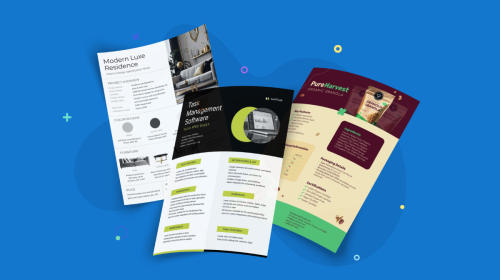
What Is a Spec Sheet? A Complete Guide with Real Examples


Did you know that 87% of consumers are unlikely to buy a product if they can't find accurate information about it?
That’s a big deal—and a major missed opportunity if your business isn’t communicating product details clearly.
Whether you're sharing info with potential customers, manufacturers, or your internal team, a spec sheet ensures everyone has the right details at a glance. It breaks down key facts like size, materials, features, pricing, and more in a clean, scannable format.
The problem? Many businesses either overlook spec sheets or underestimate just how valuable they can be.
In this guide, we’ll walk you through what a spec sheet is, why it matters, and how it’s used across industries. Plus, we’ll show you how to easily create your own spec sheet using Visme—complete with customizable templates and real-life examples to spark ideas.
Let’s dive in!
A spec sheet (or specification sheet) is a document that lists important details about a product, such as its size, materials and features. Businesses in almost every industry create spec sheets to help customers understand what a product offers before they decide to buy it.
Let’s say your company is designing a new smartphone. Before it goes into production, you must ensure everyone involved, like manufacturers, engineers and retailers, has the same information. That’s where a spec sheet comes in handy. It lists important details like screen size, battery capacity, camera features and overall weight, all in one easy-to-read document.
Additionally, once the smartphone is ready to launch into the market, you can create product spec sheets for your customers to better understand the product and make informed buying decisions.
However, it's easy to assume that spec sheets are just for electronics, which is not true. They are used in fashion, construction, engineering and even food packaging. Because no matter what you’re selling or building, clear, precise product details help avoid mistakes, speed up production, and make sure everyone, from designers to suppliers, knows exactly what to expect.
Here's a good example of a product spec sheet.
You can understand how everything about the product is specified in a concise yet easily understandable manner.
Customize this spec sheet template from Visme to recreate a similar one for your products.
There are various types of spec sheets available for manufacturing, engineering, technology, products, and other purposes.
Let’s take a look at the five main types of spec sheets and what you’ll find in each.
A product spec sheet covers the basic details of a product. It includes size, weight, material and color.
Things to include in a product spec sheet:
Here's an example of a spec sheet from Apple's iPhone 16e:
It breaks down everything you’d want to know: 6.1-inch Super Retina XDR display, A18 chip, up to 512GB storage and battery life that lasts all day. It even covers the essentials like available colors, connectivity options and camera specs, including the 48MP main lens.
Instead of digging through pages of product info, you get a clean, well-organized snapshot that makes it easy to compare features and make a smart choice.
A technical spec sheet provides detailed information about the technical aspects of the product. It helps engineers, designers and other technical users to understand how the product works and what it's capable of.
The difference between a product spec sheet and a technical spec sheet is that the latter is much more detailed than the former. Beyond the basic details, a technical spec sheet would include details like power requirements, energy efficiency and operational features.
Things to include in a technical spec sheet:
This specification page from Intel is a perfect example of a technical spec sheet.
A material spec sheet provides details about the materials used in a product. It is mostly used in industries like manufacturing, construction and design to ensure the right materials are selected for a specific purpose. These sheets help maintain consistency and quality by providing clear guidelines on material properties. They also make it easier to compare different materials and choose the best one for a project.
For example, if you're choosing wood for furniture, the spec sheet will probably tell you what type of wood it is, its hardness, durability and whether it's water-resistant. Similarly, if you're working with metals, the sheet will include details like strength, corrosion resistance and melting point.
Things to include in a material spec sheet:
Take a look at this material spec sheet of a white polyester film.
A design spec sheet helps ensure a product looks and works the way it should. It's a tool that designers, engineers, and manufacturers rely on to align their vision and maintain clarity throughout the design process.
Without a properly designed spec sheet, there could be mistakes, confusion, or products that don't match the original idea.
This type of spec sheet focuses on how a product looks, feels, and functions rather than what it's made of. For example, when designing a new smartwatch, the design spec sheet will show the screen size, button placements, strap materials, and available color options.
A good design spec sheet should include:
Here's an interior design spec sheet that explains how different interiors should be designed for a real estate project:
A marketing spec sheet provides important details about how to promote a product. It helps marketing teams identify key selling points, understand the target audience and find the best ways to advertise.
Using this spec sheet, you can ensure that your marketing materials, like ads, social media posts and brochures, communicate effectively with your target audience.
Unlike a product or design spec sheet, which focuses on technical details and appearance, a marketing spec sheet highlights why customers would want the product.
For example, if a company wants to market a fitness tracker, it could outline the target audience, such as fitness enthusiasts aged 25-40, and specify key messaging that highlights the product's unique benefits. It would also include recommended promotional channels, such as Instagram ads, influencer partnerships and email campaigns.
A strong marketing spec sheet should include:
Below is an example of a marketing spec sheet released by Spotify. It's specifically for running audio ad campaigns for a product on the platform.
We’ve shared actual examples of spec sheets in the previous section. In this section, we’ll dig deeper to provide more real-life examples of spec sheets used by popular brands along with templates you can use to create yours.
Apple’s product spec sheet for the Apple TV 4K is an excellent example of a well-structured and informative document. It includes key details such as technical specifications, features, connectivity options and supported technologies. Everything from display and performance to compatibility is laid out in clearly defined sections, so you can find what you need fast.
What makes this spec sheet more effective is its balance between depth and simplicity and relevant technical details that make the page easily understandable.
It gives buyers enough detail to make confident decisions, but it skips the fluff and avoids drowning them in tech jargon. You’ll find clear sections, concise descriptions, and relevant technical details.
You can use this Visme spec sheet template to design a similar product spec sheet for your business.
Pro Tip: Keep it short. Focus on clear, brief descriptions and avoid unnecessary jargon. Make it easy for someone to quickly understand the essential information.
Tesla's Model Y technical specification sheet is a great example of how to present information in a detailed yet structured way. It includes all the crucial aspects of the vehicle, from performance and dimensions to battery and warranty details.
I liked how they broke down the specifications into clear and concise sections to help both technical experts and everyday buyers quickly find the necessary information.
They highlighted important details like range (327 miles), acceleration (0-60 mph in 4.1 seconds) and charging speed (up to 169 miles in 15 minutes) to help potential buyers understand the vehicle's efficiency and capabilities.
Here’s a car spec sheet template from Visme’s library that you can use to create your own.
Pro Tip: Use the right tools and templates for efficiency. Starting with pre-built templates will save you a lot of time and help ensure a professional foundation for your spec sheet.
This spec sheet from Costco provides key details such as container size, type, flavor, form and net weight. It also highlights important dietary features, including dairy-free, lactose-free, organic and kosher certifications, which help consumers make informed decisions based on their dietary preferences.
I liked how well-structured this spec sheet is. It makes it easy to compare products and see if they align with what I'm looking for. The simple format and clearly organized information improve customers' shopping experience if they buy in bulk or want to choose healthier options.
Customize this food spec sheet template below and communicate the crucial nutritional information about your food product.
Pro Tip: Incorporate visuals where appropriate. Icons, images or tags can make specific data points easier to find and understand than text alone.
This Ford vehicle spec sheet does a great job of laying out the essentials—engine type, horsepower, torque, transmission—you name it. Everything is broken down into neat, scannable categories, so it’s easy to compare specs without feeling overwhelmed.
The layout deserves a shout-out, too. Clear headers, evenly spaced rows, and a smart, logical flow make it simple for readers to follow the information. There’s no guessing where to look—your eyes naturally move from one detail to the next.
Plus, the design keeps things clean. Simple fonts, minimal distractions, and a focus on the data itself make the spec sheet feel polished and professional. It’s a great reminder of something business leaders often emphasize: the best spec sheets aren’t flashy—they’re functional. The clearer and more straightforward they are, the more useful they become.
For example, Adam Young, the CEO & Founder of Event Tickets Center, believes spec sheets should be easy reference tools. Here's what he says:
"In my opinion, spec sheets should feel more like cheat sheets than like textbooks. There should be a lot of empty room, bold headers, and short bullet points."
Ford's design really follows this "cheat sheet" idea, making their information very accessible and user-friendly.
Want to create your own vehicle spec sheet? Customize this Visme vehicle spec sheet template to organize key details in a clear and professional format.
Pro Tip: Use consistent formatting and terminology. Sticking to the same styles for headings, fonts, spacing and terms throughout makes the document look professional and easier to navigate.
Here's an equipment spec sheet from LG that gives the users all the important details about the washer, like its size, features, and special functions.
At the top, there's a quick summary of the washer so you can get an idea of what it offers right away.
From there, the sheet dives into the specifics, breaking down everything from wash settings and smart features to energy efficiency and certifications. Each section is thoughtfully organized, so the user is not left digging for information.
The use of bold headings and icons makes it easy to find key details. It also highlights things like certifications and warranty, which help buyers feel more confident about their choices.
Replicate this spec sheet and create your own by using the equipment spec sheet template below from Visme.
Pro Tip: Stick to a consistent format throughout your spec sheet. Use icons, bold text, or color accents to highlight key details and make complex information easier to scan. A clean, visual layout keeps readers engaged and helps them find what they need quickly.
A well-structured product spec sheet helps you understand key details at a glance. Whether you're comparing options or sharing information with others, here are the top ways to use them:
Read this article about how to write a product spec sheet to get some practical tips and free templates that you can customize.
In this section, I will break down the most important parts of a spec sheet to make it easier for you to read a product spec sheet.
You first need to check the product name and model number to ensure you are looking at the correct product, especially when comparing several options. Some spec sheets also include a short description that explains what the product does and who it is for.
For example, in this spec sheet, the name of the product is boldly written: SpanPanel-4500.
Once you confirm the product name, look for a quick overview of the most important functions and unique features. For example, when looking at a phone, the key features might include camera quality, battery life and display type. This section helps you understand the product’s strengths without reading long descriptions.
Check out this template to understand how key features are laid out:
This is where you find numbers and measurements that describe how the product performs. Common details include size, weight, power usage, materials and speed. For example, when buying a laptop, you should check important information, including processor speed, RAM, storage capacity and battery life. It will help you decide if the product is exactly what you are looking for.
This template shows how you can structure technical specifications effectively:
Some products need to work with other devices, accessories, or software. The compatibility section tells you what the product works with, helping you avoid issues later. For example, when buying headphones, you must check whether they connect with your phone or laptop. This ensures that the product fits well into your existing setup.
Look at the “SPECIFICATIONS & REQUIREMENTS” section of this spec sheet template from Visme for your reference.
Certifications show if a product meets safety, energy efficiency, or quality standards. For example, an energy-efficient appliance might have an ENERGY STAR label. Checking this section helps you ensure the product is safe, reliable and follows the necessary regulations.
Lastly, check for any extra notes, such as special care instructions or important warnings. If a product needs specific maintenance or has any limitations, you will find out about that in this section. Reading this information can help you avoid problems later and ensure proper use of the product.
Creating a spec sheet is easier than you think, but only if you use the right tools.
Visme comes with a wide variety of tools, including a drag-and-drop editor, collaboration tools, branding kit and AI tools you can use to create a professional spec sheet in a few minutes.
But don't just take our word for it! Users consistently give Visme high ratings on major software review sites like G2 and Capterra, often highlighting its ease of use and advanced features.
Now, I will walk you through the process and also introduce you to all the Visme features that will help you along the way.
To get started, sign up for a free Visme account if you don’t already have one. Sign up using your email ID or Facebook account, which takes only a few minutes.
After signing up, head to Visme’s template library and choose a spec sheet template that fits your needs.
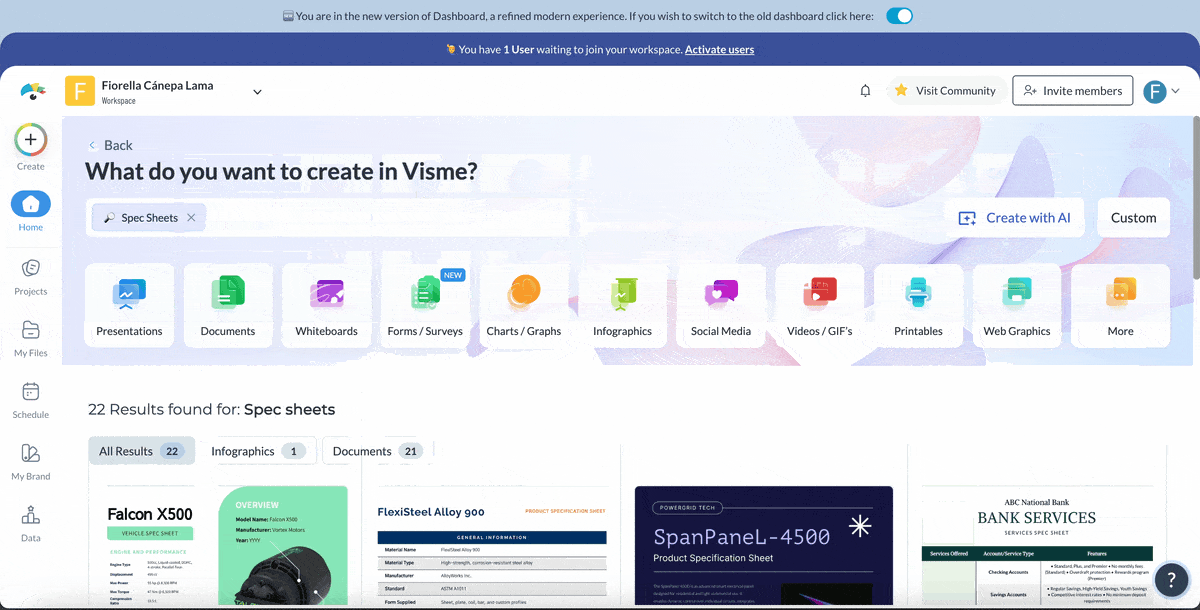
With Visme, you get access to a huge library of templates. Whether you’re working on a product spec sheet, a technical spec sheet, or a marketing spec sheet, you can start with a ready-made design and make it your own. Customize the text, colors, fonts, sections and layout to fit your needs.
Once you’ve chosen a template, it’s time to customize the template to fit your needs. This is where the real magic happens. Visme’s drag-and-drop editor will help you customize the template easily. Just follow these instructions properly and you wil be good to go:
Start by clicking on any text box in your template to add product names, features, materials, dimensions or pricing. You can also add more text boxes if needed by dragging them from the left-side panel.
To display technical details clearly, you can use tables. In Visme, you can drag and drop a table from the "Data" tab. Simply click to edit the cells and enter your specifications, like weight, size, color options or model numbers.
Visme lets you connect your tables with Google Sheets or MS Excel, so you don't have to manually enter the data. Also, whenever you make changes to your source table, the change will be reflected on your Visme project, making data entry very convenient and easy.
To add product images, head over to the "Photos" tab. Upload your own images or browse Visme's stock images library to access 1M+ images.
Do you want to include a unique image on your spec sheet that's hard to find elsewhere? Try Visme's AI image generator to create custom visuals based on text prompts.
Additionally, you can edit your images using Visme's AI image editing tools. It lets you upscale, unblur, touch and edit your images to get the perfect visual for your spec sheet using just text prompts.

Keep your spec sheet on-brand by using Visme's Brand Wizard. Just paste your company's website URL, and Visme will automatically extract your brand colors, brand fonts and company logo in seconds.

You can then save these elements under the "My Brand" section on your dashboard. Once saved, apply your brand to any design by just clicking "Brand Kit" and choosing your brand. Your colors, fonts and logo will be instantly added to your project.
But why is applying your branding consistently so crucial? It's more than just looks.
Here's what Noel Griffith, Chief Marketing Officer at SupplyGem, has to say about it:
"Maintaining consistency in branding elements such as color schemes, typography, and logo placement reinforces brand identity and lends a professional touch to the document. This consistency ensures that the spec sheet aligns with other marketing materials, providing a cohesive brand experience."
Want to make your spec sheet more engaging? Visme lets you add interactive elements with just a few clicks, without any coding.
You can link buttons, text or images to a website, product page, or slide. Just click on the element, then hit the “Link” icon on the top bar to add your URL or choose where you want it to go.
You can also add pop-ups, hover effects and slide transitions to guide your audience through your content step by step. It’s a great way to turn a static spec sheet into an interactive experience that keeps people clicking.
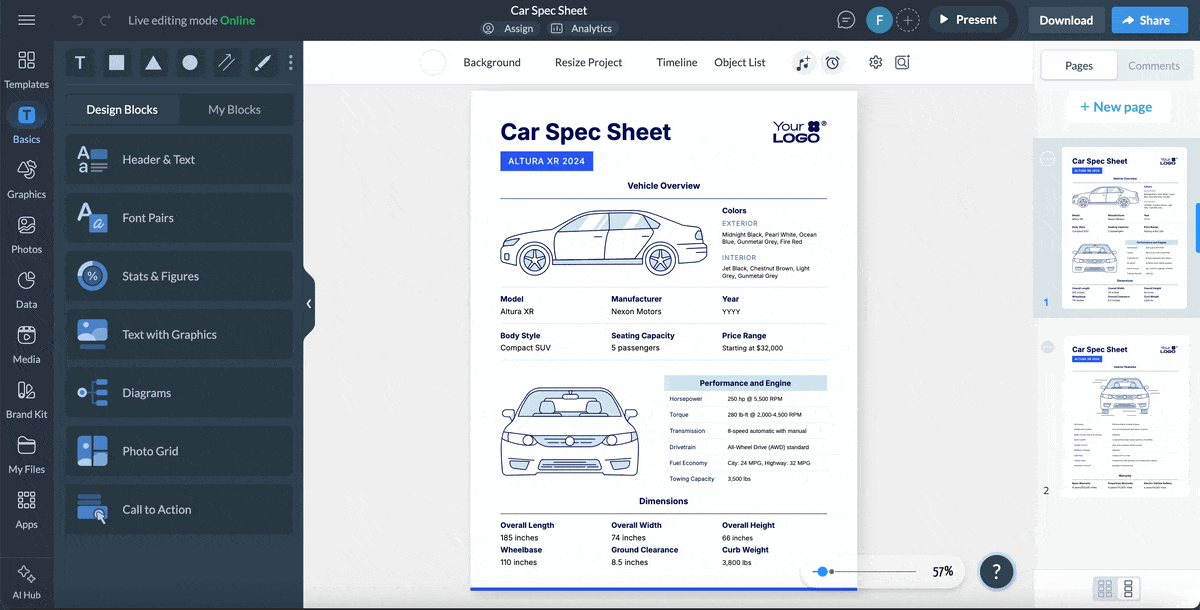
Creating a spec sheet often involves input from multiple departments, like design, marketing, product and sales. That’s why collaboration is key to making sure all details are accurate and on-brand.
Visme’s collaborative design features make it easy to collaborate with your team in real time. You can invite teammates to view, comment, annotate, or live edit your spec sheet, which is perfect for collecting feedback and making quick changes together.
Additionally, using Visme’s workflow management features, project admins can assign roles, set permissions, manage deadlines and track progress all in one place. This gives you a clear bird’s-eye view of who’s doing what and when.
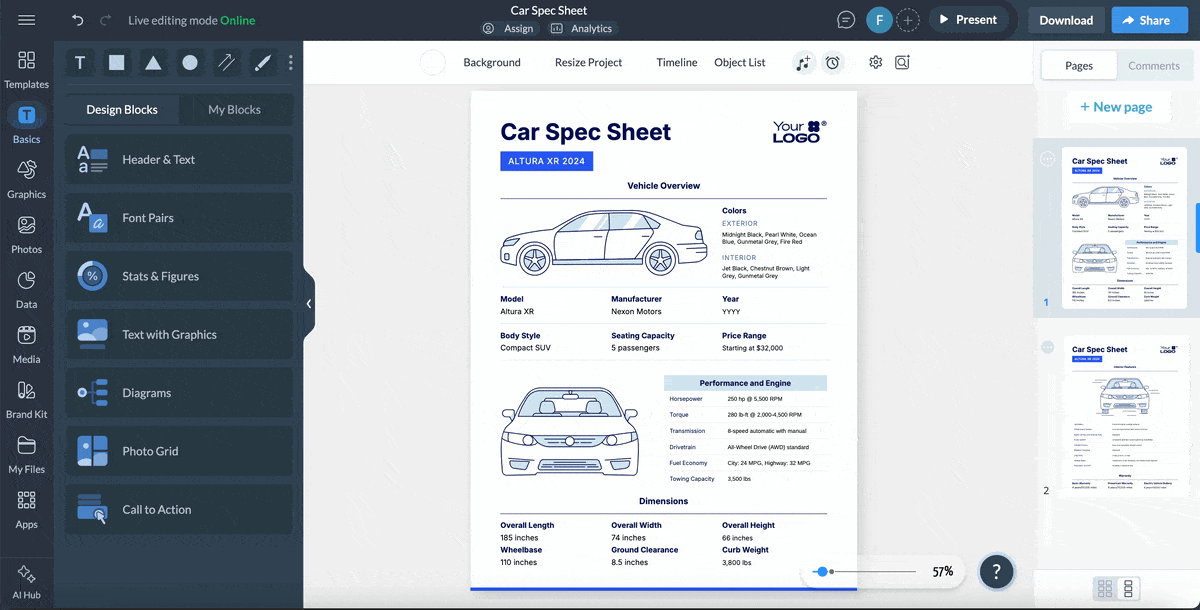
Once your spec sheet is ready, you can easily download it in multiple formats like JPG, PNG, PDF, or HTML. Choose the format that works best for your needs.
If you want to share it online, Visme allows you to generate a shareable link to send to others or share directly on social media like Facebook, LinkedIn or X.
For website integration, simply use the embed code snippet Visme provides to place your spec sheet on any webpage. This makes it easy to share or display your spec sheet with anyone, anywhere.
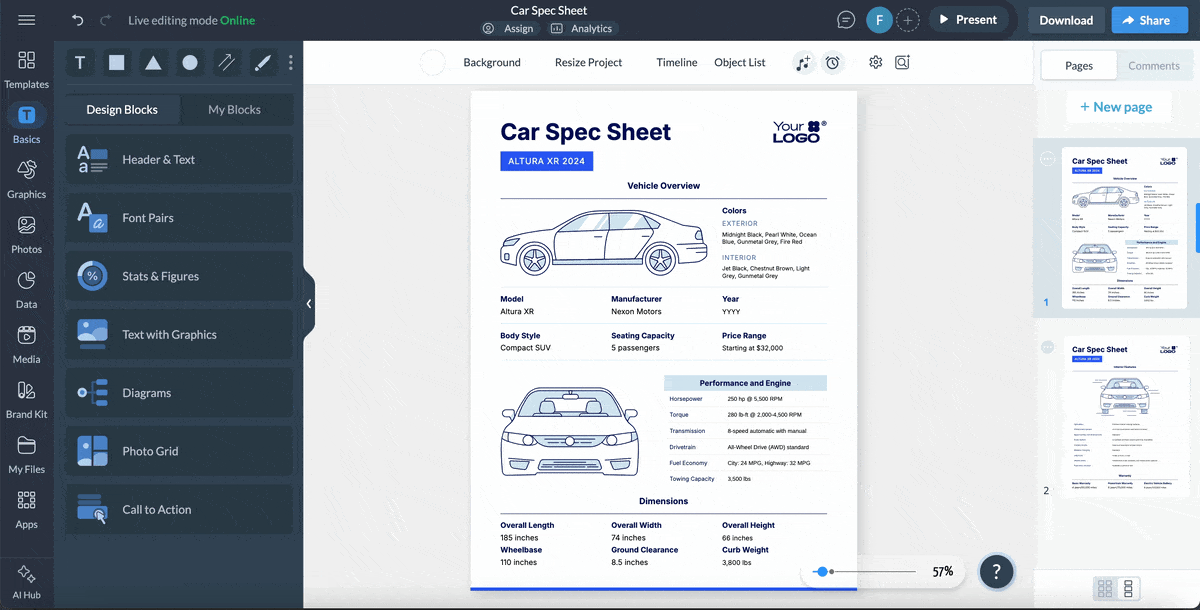
Spec sheets aren’t just for engineers; they’re helpful for anyone who needs to communicate clear, detailed information. You can use them if you are any of the professionals in this list:
A tech pack is a detailed document that designers and manufacturers use to outline how a product is made, including materials, construction and technical specifications.
A spec sheet, on the other hand, focuses more on the technical details of the product itself, such as dimensions, weight, features and other specifications. While both documents provide important product details, a tech pack is often used in manufacturing, and a spec sheet is more commonly used for sales or marketing purposes.
A spec sheet can also be called a specification sheet, data sheet or product info Sheet. All of these terms refer to documents that provide key details about a product, like size, weight, features and other important information. Here are some real-life product specification examples you can learn from.
A spec sheet is simple and focuses on the product’s physical attributes and features. It lists important information like dimensions, color options, and materials. It’s designed to provide potential buyers with a quick overview and assist them in making informed decisions.
In contrast, a data sheet goes much deeper into the technical details. It’s often used for complex products like electronics or machinery. It includes specifications such as performance data, test results, power requirements and other technical information. It’s meant for engineers or professionals who need in-depth information to assess the product’s capabilities.
In construction, a spec sheet describes the materials, products, and systems used in a building project. It provides detailed specifications about the quality, size, and standards of construction materials, such as doors, windows and plumbing systems.
A spec sheet is a comprehensive document that provides all the necessary technical details about a product. It’s a reference for consumers and professionals alike, explaining everything from size to materials and features.
On the other hand, A tear sheet is more like a marketing flyer. It’s designed to catch attention quickly, often featuring only a product’s most attractive or important features. It’s visually focused and meant to be handed out or posted for quick viewing.
While a spec sheet gives all the details, a tear sheet is meant to make an impression and spark interest.
Creating a spec sheet from scratch can feel overwhelming, especially when you need to communicate complex product details, use branding elements and visualize data. But with the right tools, the process can be smooth and efficient.
Visme makes it easy to design professional, well-structured spec sheets without any design experience. With drag-and-drop editing, live data integration, brand design tools and interactive elements, you can create a visually appealing and highly functional spec sheet in minutes.
Plus, Visme’s collaboration features ensure that your entire team stays on the same page throughout the design process.
However, with Visme, you are not only limited to designing spec sheets. It helps you create almost all types of marketing materials, from flyers and posters to case studies and sales playbooks, without any design experience.
Sign up for a free Visme account today and start marketing your products effectively.
Design visual brand experiences for your business whether you are a seasoned designer or a total novice.
Try Visme for free